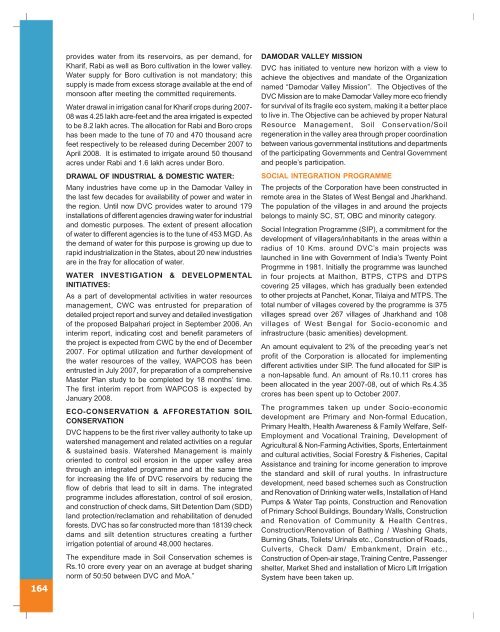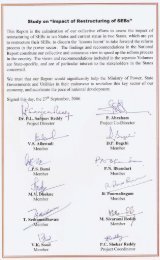MoP - Ministry of Power
MoP - Ministry of Power
MoP - Ministry of Power
You also want an ePaper? Increase the reach of your titles
YUMPU automatically turns print PDFs into web optimized ePapers that Google loves.
164<br />
provides water from its reservoirs, as per demand, for<br />
Kharif, Rabi as well as Boro cultivation in the lower valley.<br />
Water supply for Boro cultivation is not mandatory; this<br />
supply is made from excess storage available at the end <strong>of</strong><br />
monsoon after meeting the committed requirements.<br />
Water drawal in irrigation canal for Kharif crops during 2007-<br />
08 was 4.25 lakh acre-feet and the area irrigated is expected<br />
to be 8.2 lakh acres. The allocation for Rabi and Boro crops<br />
has been made to the tune <strong>of</strong> 70 and 470 thousand acre<br />
feet respectively to be released during December 2007 to<br />
April 2008. It is estimated to irrigate around 50 thousand<br />
acres under Rabi and 1.6 lakh acres under Boro.<br />
DRAWAL OF INDUSTRIAL & DOMESTIC WATER:<br />
Many industries have come up in the Damodar Valley in<br />
the last few decades for availability <strong>of</strong> power and water in<br />
the region. Until now DVC provides water to around 179<br />
installations <strong>of</strong> different agencies drawing water for industrial<br />
and domestic purposes. The extent <strong>of</strong> present allocation<br />
<strong>of</strong> water to different agencies is to the tune <strong>of</strong> 453 MGD. As<br />
the demand <strong>of</strong> water for this purpose is growing up due to<br />
rapid industrialization in the States, about 20 new industries<br />
are in the fray for allocation <strong>of</strong> water.<br />
WATER INVESTIGATION & DEVELOPMENTAL<br />
INITIATIVES:<br />
As a part <strong>of</strong> developmental activities in water resources<br />
management, CWC was entrusted for preparation <strong>of</strong><br />
detailed project report and survey and detailed investigation<br />
<strong>of</strong> the proposed Balpahari project in September 2006. An<br />
interim report, indicating cost and benefit parameters <strong>of</strong><br />
the project is expected from CWC by the end <strong>of</strong> December<br />
2007. For optimal utilization and further development <strong>of</strong><br />
the water resources <strong>of</strong> the valley, WAPCOS has been<br />
entrusted in July 2007, for preparation <strong>of</strong> a comprehensive<br />
Master Plan study to be completed by 18 months’ time.<br />
The first interim report from WAPCOS is expected by<br />
January 2008.<br />
ECO-CONSERVATION & AFFORESTATION SOIL<br />
CONSERVATION<br />
DVC happens to be the first river valley authority to take up<br />
watershed management and related activities on a regular<br />
& sustained basis. Watershed Management is mainly<br />
oriented to control soil erosion in the upper valley area<br />
through an integrated programme and at the same time<br />
for increasing the life <strong>of</strong> DVC reservoirs by reducing the<br />
flow <strong>of</strong> debris that lead to silt in dams. The integrated<br />
programme includes afforestation, control <strong>of</strong> soil erosion,<br />
and construction <strong>of</strong> check dams, Silt Detention Dam (SDD)<br />
land protection/reclamation and rehabilitation <strong>of</strong> denuded<br />
forests. DVC has so far constructed more than 18139 check<br />
dams and silt detention structures creating a further<br />
irrigation potential <strong>of</strong> around 48,000 hectares.<br />
The expenditure made in Soil Conservation schemes is<br />
Rs.10 crore every year on an average at budget sharing<br />
norm <strong>of</strong> 50:50 between DVC and MoA.”<br />
DAMODAR VALLEY MISSION<br />
DVC has initiated to venture new horizon with a view to<br />
achieve the objectives and mandate <strong>of</strong> the Organization<br />
named “Damodar Valley Mission”. The Objectives <strong>of</strong> the<br />
DVC Mission are to make Damodar Valley more eco friendly<br />
for survival <strong>of</strong> its fragile eco system, making it a better place<br />
to live in. The Objective can be achieved by proper Natural<br />
Resource Management, Soil Conservation/Soil<br />
regeneration in the valley area through proper coordination<br />
between various governmental institutions and departments<br />
<strong>of</strong> the participating Governments and Central Government<br />
and people’s participation.<br />
SOCIAL INTEGRATION PROGRAMME<br />
The projects <strong>of</strong> the Corporation have been constructed in<br />
remote area in the States <strong>of</strong> West Bengal and Jharkhand.<br />
The population <strong>of</strong> the villages in and around the projects<br />
belongs to mainly SC, ST, OBC and minority category.<br />
Social Integration Programme (SIP), a commitment for the<br />
development <strong>of</strong> villagers/inhabitants in the areas within a<br />
radius <strong>of</strong> 10 Kms. around DVC’s main projects was<br />
launched in line with Government <strong>of</strong> India’s Twenty Point<br />
Progrmme in 1981. Initially the programme was launched<br />
in four projects at Maithon, BTPS, CTPS and DTPS<br />
covering 25 villages, which has gradually been extended<br />
to other projects at Panchet, Konar, Tilaiya and MTPS. The<br />
total number <strong>of</strong> villages covered by the programme is 375<br />
villages spread over 267 villages <strong>of</strong> Jharkhand and 108<br />
villages <strong>of</strong> West Bengal for Socio-economic and<br />
infrastructure (basic amenities) development.<br />
An amount equivalent to 2% <strong>of</strong> the preceding year’s net<br />
pr<strong>of</strong>it <strong>of</strong> the Corporation is allocated for implementing<br />
different activities under SIP. The fund allocated for SIP is<br />
a non-lapsable fund. An amount <strong>of</strong> Rs.10.11 crores has<br />
been allocated in the year 2007-08, out <strong>of</strong> which Rs.4.35<br />
crores has been spent up to October 2007.<br />
The programmes taken up under Socio-economic<br />
development are Primary and Non-formal Education,<br />
Primary Health, Health Awareness & Family Welfare, Self-<br />
Employment and Vocational Training, Development <strong>of</strong><br />
Agricultural & Non-Farming Activities, Sports, Entertainment<br />
and cultural activities, Social Forestry & Fisheries, Capital<br />
Assistance and training for income generation to improve<br />
the standard and skill <strong>of</strong> rural youths. In infrastructure<br />
development, need based schemes such as Construction<br />
and Renovation <strong>of</strong> Drinking water wells, Installation <strong>of</strong> Hand<br />
Pumps & Water Tap points, Construction and Renovation<br />
<strong>of</strong> Primary School Buildings, Boundary Walls, Construction<br />
and Renovation <strong>of</strong> Community & Health Centres,<br />
Construction/Renovation <strong>of</strong> Bathing / Washing Ghats,<br />
Burning Ghats, Toilets/ Urinals etc., Construction <strong>of</strong> Roads,<br />
Culverts, Check Dam/ Embankment, Drain etc.,<br />
Construction <strong>of</strong> Open-air stage, Training Centre, Passenger<br />
shelter, Market Shed and installation <strong>of</strong> Micro Lift Irrigation<br />
System have been taken up.

















